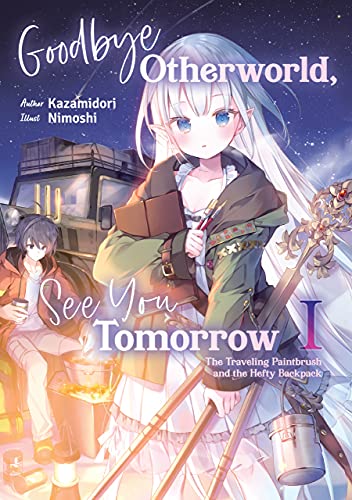By Kazamidori and Nimoshi. Released in Japan as “Sayonara Isekai, Mata Kite Ashita” by Fujimi Fantasia Bunko. Released in North America digitally by J-Novel Club. Translated by MPT.
We tend to see, with isekai novels, a hero summoned to a world that’s in peril, usually by the royal family. Sometimes the summons goes wrong, or they summon some other person they didn’t want. We’ve even seen a few where the hero was summoned AFTER the big bad has been defeated, leaving them with nothing to do. We’ve seen heroes fail, and usually they go back in time to try to get it right this time or they’re reincarnated long into the future. But this one in particular is a bit much – by the time our hero, who is living in the woods after running away from his family, stumbles across another world, the world has lost almost everyone in it, turned to crystals by a sudden explosion of mana. All our hero can do, really, is drive around, try to get supplies and possibly find the dark man who gave him advice when he first arrived, and find a reason to go on. The last proves the hardest.
Keisuke does not have much, just his watch and phone (which don’t get more reception from Japan here) and a big truck that he doesn’t really know how to drive that well. Then the truck breaks down when he gets to an abandoned train station. Fortunately, he runs into a half-elf named Nito, who is a painter by trade and reluctantly starts to open up to him seeing as her means of transport is also busted. Together they get their respective vehicles repaired thanks to the last mechanic in the world who responds to distress flares, and set out on a journey – him to find the dark man I mentioned earlier, and her to see if her mother was telling her the truth when she talked about the Golden Sea in a book of paintings that are Nito’s most treasured possession.
So, spoiling something important right here and now: no one commits suicide in this book. This is important to note because we have no less than four different suicidal people at some point i this book, either genuinely trying and failing to take their life or having given up all hope on living. The fact that they do live, and that the See You Tomorrow in the title is meant to be uplifting and affirming, is probably the best thing about the book. The other big plus is the evocative prose – there’s a sense of Kino’s Journey to this series, but it doesn’t have an anti-war agenda like that does, and the disaster that wiped out nearly everyone remains a mystery by the end of the book. Instead we get a series of scenes where we see people who want to end their life finding reason to go on by communicating with others. I love that. It’s a series of passing meetings, but each one has impact.
I’d heard this was the most anticipated of the four J-Novel Club licenses that came out at the same time, and I can see why. It’s just a treat to read, though again I warn there are suicidal thoughts and suicide attempts in this. If you want a different sort of isekai, this is the one for you.


Speak Your Mind